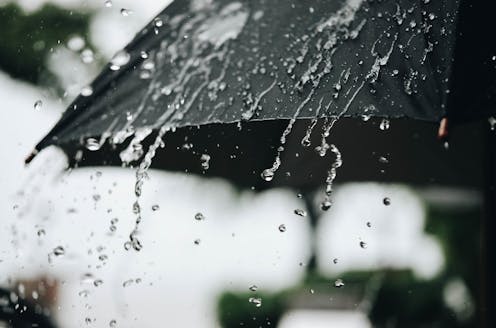What's the record for how long it's ever rained without stopping?
- Written by Lynn McMurdie, Research Associate Professor of Atmospheric Sciences, University of Washington

An exception to this rule is where mountains are near oceans. In that case, as moist ocean air blows toward the land, it encounters the mountains and is forced to lift over them. Clouds can form there almost continuously, bringing rainfall that can last for weeks or longer.
Days and days of rain
Rainfall records exist only in places where people live and keep records. Many towns and cities don’t bother collecting rainfall data. And records don’t exist for the many uninhabited locations on Earth, like over the ocean or deep in rain forests. So rainfall data is incomplete.
In modern record keeping, rainfall is measured by the amount in a given time period, usually hourly or daily. A few drops of rain is called a “trace” of rain. Rainfall is “measurable” if it adds up to 0.01 inch (0.25 millimeters) or more.
In the U.S., the longest periods of daily rain have occurred in Hawaii, where easterly trade winds blow toward the mountains. An incredible 331 consecutive days of measurable rainfall[7] were recorded at Manuawili Ranch, Maui, in 1939-40. If you include a trace of rain, the record is 881 consecutive days, or nearly three straight years[8], at Honomu Maki, Oahu, from 1913 to 1916. This dependable and continuous rainfall is the reason that region is a tropical rainforest.
In the continental U.S., the longest daily rainfalls have occurred in winter near the coastal mountain ranges of the Pacific Northwest. In 1997-98, Otis, Oregon, received 79 straight days[10] of measurable rainfall. The Pacific Northwest has temperate rainforests, where the continuously wet cold season nurtures huge trees, even though it is often relatively dry in the summer.
There are plenty of other rainy places in the world[11] where moist air flows over mountains. The Meteorological Observatory in Cherrapunjee, India, recorded 86 consecutive days of measurable rainfall[12] during the monsoon in 1995. Other rainy places include Southern New Zealand, Bioko Island in Equatorial Guinea and western Colombia in South America.
If you want to know how much it rains where you live, the best way is to install a rain gauge and start recording your own daily rainfall measurements. A great resource is the CoCoRahs Network[14], a community of volunteers working to measure and map rain, hail and snow.
Collecting data about the location and intensity of all kinds of precipitation really helps scientists like us understand weather systems and improve our weather forecasting.
Hello, curious kids! Do you have a question you’d like an expert to answer? Ask an adult to send your question to CuriousKidsUS@theconversation.com[15]. Please tell us your name, age and the city where you live.
And since curiosity has no age limit – adults, let us know what you’re wondering, too. We won’t be able to answer every question, but we will do our best.
References
- ^ Curious Kids (theconversation.com)
- ^ curiouskidsus@theconversation.com (theconversation.com)
- ^ scientists who (scholar.google.com)
- ^ study the weather (scholar.google.com)
- ^ Together they look like clouds (theconversation.com)
- ^ Mario Tama via Getty Images News (www.gettyimages.com)
- ^ 331 consecutive days of measurable rainfall (weather.com)
- ^ nearly three straight years (weather.com)
- ^ CC BY-ND (creativecommons.org)
- ^ Otis, Oregon, received 79 straight days (wrcc.dri.edu)
- ^ other rainy places in the world (www.escape.com.au)
- ^ Cherrapunjee, India, recorded 86 consecutive days of measurable rainfall (cherrapunjee.com)
- ^ Morel J/Andia/Universal Images Group via Getty Images (www.gettyimages.com)
- ^ CoCoRahs Network (www.cocorahs.org)
- ^ CuriousKidsUS@theconversation.com (theconversation.com)
Authors: Lynn McMurdie, Research Associate Professor of Atmospheric Sciences, University of Washington
Read more https://theconversation.com/whats-the-record-for-how-long-its-ever-rained-without-stopping-167869

